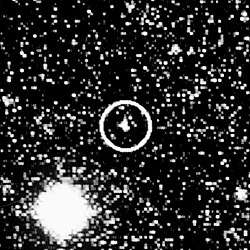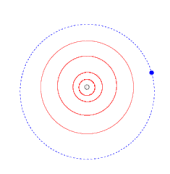15760 Albion
15760 Albion, provisional designation 1992 QB1, was the first trans-Neptunian object to be discovered after Pluto and Charon. Measuring about 108–167 kilometres in diameter, it was discovered in 1992 by David C. Jewitt and Jane X. Luu at the Mauna Kea Observatory, Hawaii. After the discovery, they dubbed the object ‘Smiley’ and it was shortly hailed as the tenth planet by the press.[9][10] It is a "cold" classical Kuiper belt object and gave rise to the name cubewano for this kind of object, after the QB1 portion of its designation.[11] Decoding its provisional designation, "QB1" reveals that it was the 27th object found in the second half of August of that year. As of January 2018, over 2,400 further objects have been found beyond Neptune, a majority of which are classical Kuiper belt objects. It was named after Albion from William Blake's mythology.[12]
 Long-exposure image of Albion (circled) taken by the European Southern Observatory in September 1992 | |
| Discovery [1][2] | |
|---|---|
| Discovered by | D. C. Jewitt J. X. Luu |
| Discovery site | Mauna Kea Obs. |
| Discovery date | 30 August 1992 |
| Designations | |
| (15760) Albion | |
| Pronunciation | /ˈælbiən/ |
Named after | Albion [3] (mythology by William Blake) |
| 1992 QB1 | |
| TNO [1] · cubewano [4][5] (cold)[6] distant [3] | |
| Orbital characteristics [1] | |
| Epoch 27 April 2019 (JD 2458600.5) | |
| Uncertainty parameter 3 | |
| Observation arc | 21.10 yr (7,707 days) |
| Aphelion | 46.753 AU |
| Perihelion | 40.804 AU |
| 43.779 AU | |
| Eccentricity | 0.0679 |
| 289.67 yr (105,802 days) | |
| 33.562° | |
| 0° 0m 12.24s / day | |
| Inclination | 2.1828° |
| 359.34° | |
| 0.6029° | |
| Physical characteristics | |
Mean diameter | 108 km[6] 167 km[4] |
| 0.2 (assumed)[6] | |
| RR[7] | |
| 23.3[8] | |
| 7.1[1] | |
Naming

This minor planet was named after Albion from the complex mythology of English poet and painter William Blake (1757–1827). Albion is the island-dwelling primeval man whose division resulted into The Four Zoas: Urizen, Tharmas, Luvah/Orc and Urthona/Los. The name Albion itself derives from the ancient and mythological name of Britain.[3] The official naming citation was published by the Minor Planet Center on 31 January 2018 (M.P.C. 108697).[13]
The discoverers suggested the name "Smiley" for (15760) 1992 QB1,[14] but the name was already used for an asteroid 1613 Smiley, named after the American astronomer Charles Hugh Smiley. It has received the number 15760[5] and remained unnamed until January 2018 (it was normally referred to simply as "QB1", even though this was technically ambiguous without the year of discovery).
Legacy
The next year in 1993, objects in similar orbits were found including (15788) 1993 SB, (15789) 1993 SC, (181708) 1993 FW, and (385185) 1993 RO.
Over one thousand bodies were found the Kuiper belt between orbiting between about 30-50 AU from the Sun in the twenty years (1992-2012), after finding 1992 QB1 (named in 2018, 15760 Albion), showing a vast belt of bodies more than just Pluto and Albion.[15][16] By 2018, over 2000 Kuiper belts objects were discovered.[16]
Notes
^ Minor planet and asteroid provisional designations follow a format, in which the year it was discovered comes first, followed by the half-month it was discovered alphabetically (e.g. A=January 1–15, B=January 16–31 and so on, but skipping the letters I and Z) and then the order of its discovery alphabetically followed by a number (e.g. 1992 QA, 1992 QB, 1992 QC ... 1992 QY, 1992 QZ, 1992 QA1, 1992 QB1 and so on.) According to this, Q=August 16–31 and B1=25+2=27.
References
- "JPL Small-Body Database Browser: 15760 Albion (1992 QB1)" (2013-10-06 last obs.). Jet Propulsion Laboratory. Retrieved 16 September 2019.
- "IAUC 5611: 1992 QB1". IAU Minor Planet Center. 14 September 1992. Retrieved 2011-07-05.
- "15760 Albion (1992 QB1)". Minor Planet Center. Retrieved 6 February 2018.
- William Robert Johnston (28 December 2015). "List of Known Trans-Neptunian Objects". Johnston's Archive. Retrieved 2015-01-03.
- Marc W. Buie (30 November 1999). "Orbit Fit and Astrometric record for 15760". SwRI, Space Science Department. Retrieved 2008-09-28.
- Mike Brown, 'How many dwarf planets are there in the outer solar system?' Archived October 18, 2011, at the Wayback Machine Accessed 2014-11-19
- Marcello Fulchignoni; Irina Belskaya; Maria Antonietta Barucci; Maria Cristina De Sanctis; Alain Doressoundiram (2008). "Transneptunian Object Taxonomy" (PDF). The Solar System Beyond Neptune.
- "AstDys (15760) Albion Ephemerides". Department of Mathematics, University of Pisa, Italy. Retrieved 2010-03-03.
- Collander-Brown, S.; Maran, M.; Williams, I. P. (2000-10-11). "The effect on the Edgeworth-Kuiper Belt of a large distant tenth planet". Monthly Notices of the Royal Astronomical Society. 318 (1): 101–108. doi:10.1046/j.1365-8711.2000.03640.x. ISSN 0035-8711.
- Coote, Roger. / (August 2008). The earth. London. ISBN 9781842399491. OCLC 671197414.
- Dr. David Jewitt. "Classical Kuiper Belt Objects". David Jewitt/UCLA. Archived from the original on November 4, 2013. Retrieved July 1, 2013.
- "(15760) Albion = 1992 QB1". IAU Minor Planet Center.
- "MPC/MPO/MPS Archive". Minor Planet Center. Retrieved 6 February 2018.
- What Lurks in the Outer Solar System? (Science@NASA, 13 September 2001)
- "The Kuiper Belt at 20". Astrobiology Magazine. 2012-09-01. Retrieved 2019-12-01.
- Dyches, By Preston. "10 Things to Know About the Kuiper Belt". NASA Solar System Exploration. Retrieved 2019-12-01.